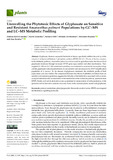Mostrar el registro sencillo del ítem
Unravelling the phytotoxic effects of glyphosate on sensitive and resistant Amaranthus Palmeri populations by GC-MS and LC-MS metabolic profiling
| dc.creator | Zulet González, Ainhoa | es_ES |
| dc.creator | Gorzolka, Karin | es_ES |
| dc.creator | Döll, Stefanie | es_ES |
| dc.creator | Gil Monreal, Miriam | es_ES |
| dc.creator | Royuela Hernando, Mercedes | es_ES |
| dc.creator | Zabalza Aznárez, Ana | es_ES |
| dc.date.accessioned | 2023-07-27T15:19:43Z | |
| dc.date.available | 2023-07-27T15:19:43Z | |
| dc.date.issued | 2023 | |
| dc.identifier.citation | Zulet-Gonzalez, A., Gorzolka, K., Döll, S., Gil-Monreal, M., Royuela, M., Zabalza-Aznárez, A. (2023) Unravelling the phytotoxic effects of glyphosate on sensitive and resistant Amaranthus Palmeri populations by GC-MS and LC-MS metabolic profiling. Plants, 12(6), 1-17. https://doi.org/10.3390/plants12061345. | en |
| dc.identifier.issn | 2223-7747 | |
| dc.identifier.uri | https://hdl.handle.net/2454/45846 | |
| dc.description.abstract | Glyphosate, the most successful herbicide in history, specifically inhibits the activity of the enzyme 5-enolpyruvylshikimate-3-phosphate synthase (EPSPS; EC 2.5.1.19), one of the key enzymes in the shikimate pathway. Amaranthus palmeri is a driver weed in agriculture today that has evolved glyphosate-resistance through increased EPSPS gene copy number and other mechanisms. Non-targeted GC–MS and LC–MS metabolomic profiling was conducted to examine the innate physiology and the glyphosate-induced perturbations in one sensitive and one resistant (by EPSPS amplification) population of A. palmeri. In the absence of glyphosate treatment, the metabolic profile of both populations was very similar. The comparison between the effects of sublethal and lethal doses on sensitive and resistant populations suggests that lethality of the herbicide is associated with an amino acid pool imbalance and accumulation of the metabolites of the shikimate pathway upstream from EPSPS. Ferulic acid and its derivatives were accumulated in treated plants of both populations, while quercetin and its derivative contents were only lower in the resistant plants treated with glyphosate. | en |
| dc.description.sponsorship | This work was funded by the Spanish Ministry of Economy and Competitiveness (AGL2016-77531-R) and Spanish Ministry of Science and Innovation (2020 117723-RB-100). A. Z-G received funding from fellowship through Universidad Pública de Navarra. | en |
| dc.format.mimetype | application/pdf | en |
| dc.language.iso | eng | en |
| dc.publisher | MDPI | en |
| dc.relation.ispartof | Plants 2023, 12(6), 1345 | en |
| dc.rights | © 2023 by the authors. Licensee MDPI, Basel, Switzerland. This article is an open access article distributed under the terms and conditions of the Creative Commons Attribution (CC BY) license. | en |
| dc.rights.uri | http://creativecommons.org/licenses/by/4.0/ | |
| dc.subject | EPSPS | en |
| dc.subject | Flavonoids | en |
| dc.subject | Mode of action | en |
| dc.subject | Non-targeted metabolomics | en |
| dc.subject | Phenylpropanoids | en |
| dc.subject | Primary metabolism | en |
| dc.subject | Signalling molecules | en |
| dc.title | Unravelling the phytotoxic effects of glyphosate on sensitive and resistant Amaranthus Palmeri populations by GC-MS and LC-MS metabolic profiling | en |
| dc.type | Artículo / Artikulua | es |
| dc.type | info:eu-repo/semantics/article | en |
| dc.date.updated | 2023-07-27T15:15:36Z | |
| dc.contributor.department | Institute for Multidisciplinary Research in Applied Biology - IMAB | en |
| dc.rights.accessRights | Acceso abierto / Sarbide irekia | es |
| dc.rights.accessRights | info:eu-repo/semantics/openAccess | en |
| dc.identifier.doi | 10.3390/plants12061345 | |
| dc.relation.projectID | info:eu-repo/grantAgreement/MINECO//AGL2016-77531-R | en |
| dc.relation.projectID | info:eu-repo/grantAgreement/MICINN//2020 117723-RB-100 | en |
| dc.relation.publisherversion | https://doi.org/10.3390/plants12061345 | |
| dc.type.version | Versión publicada / Argitaratu den bertsioa | es |
| dc.type.version | info:eu-repo/semantics/publishedVersion | en |
| dc.contributor.funder | Universidad Pública de Navarra / Nafarroako Unibertsitate Publikoa | es |




